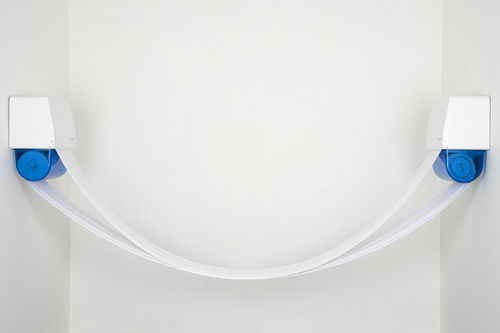Tim Taylor graduated from Edinburgh College of Art and continues to live and work in Edinburgh. His artwork celebrates the quotidian and the commonplace, both as subject and material. He has shown locally, nationally and internationally (from Kirkcudbright in Scotland to Ekaterinburg in Russia) and in a variety of environments and mediums, from gallery-based work to public installation and performance. In 2008 he swam Edinburgh’s hidden water course of public and private pools from the hills to the sea in a day, walking between them in sandals and robe. His most recent project saw the award-winning installation of twenty-six works embedded within the building fabric of a healthcare centre for children in Glasgow.

What are some recent, upcoming or current projects you are working on? I am currently working on an installation using ten years worth of collected, flattened road debris and am also working on a long-running project constructing every water tower (‘Wassertürme’) photographed by celebrated photographers, Hilla and Bernd Becher, out of matchsticks. I have made 32 and have 191 to go…
What is one of the bigger challenges you and other artists are struggling with these days, and how do you see it developing? For better or for worse, information overload. A rise in the popularity of hermits’ caves seems likely.
When and where did your interest in art begin? Probably around the age of 9. I drew a whale at school that I thought was the finest thing. That same year I met my first ‘real’ artist, a Swede called called Ulf, who showed me how to draw flag and my father took me to an exhibition of work by the surrealist painter Magritte that left a lasting impression on me.
What materials do you use in your work and what is your process like? I use everyday commodities such as ice, soap, sand, red wine, salt, shower screens, matchsticks, scouring pads, queue barriers, to attempt a mild alchemy, a transformation of the ordinary to the extra-ordinary; the familiar to the unfamiliar. Sometimes this can be the simple relationship between two found objects, sometimes the exaggeration of a domestic incident.
Whilst I seek to achieve the greatest effect with the least effort some of my work requires considerable effort, the current matchstick water towers being a case in point. I like to use what is around me. There’s a fine tradition in this. After all, what did we use when there were no such thing as ‘art materials’? The stuff that lay around us, mud!
What’s your favorite thing about Edinburgh? You can always see the hills on a clear day and you can be in them very quickly.
What was the last exhibition you saw that stuck out to you? Taysir Batniji‘s photographs of Palestinian watchtowers at the KW in Berlin.
Any current or upcoming shows we should know about? I’ve recently submitted a couple of instructional works to a gallery in the USA that I hope will be realized in my absence.
Favorite music? My wife’s cello, though I am liable to weep.
Can you share one of the best or worst reactions you have gotten as a result of your work? A reviewer once called my work mundane. Whilst I’m sure this was not meant as a compliment, I took it as such, given that I worship at the alter of mundanity.
Embarrassing moments? Walking in to the school canteen with my nether regions hanging out of my trousers. I was holding a tray so had no idea. Fortunately that was just a strange dream!
With regard to my art, assembling a professional film crew and set-build to record my first Domestic Erosion series early one Sunday morning. The piece involved the melting of cubic blocks of clear ice with various domestic appliances. I was informed by the refrigeration company that the three blocks of ice had not frozen. The iceman did finally cometh, albeit a week late.
Good friends of mine were somewhat embarrassed at a show of mine when their eight year old son decided to jump on a humming table I had constructed with golden vibrators as legs. The whole thing collapsed with him in the middle of it. Not the sort of interaction I had foreseen!







